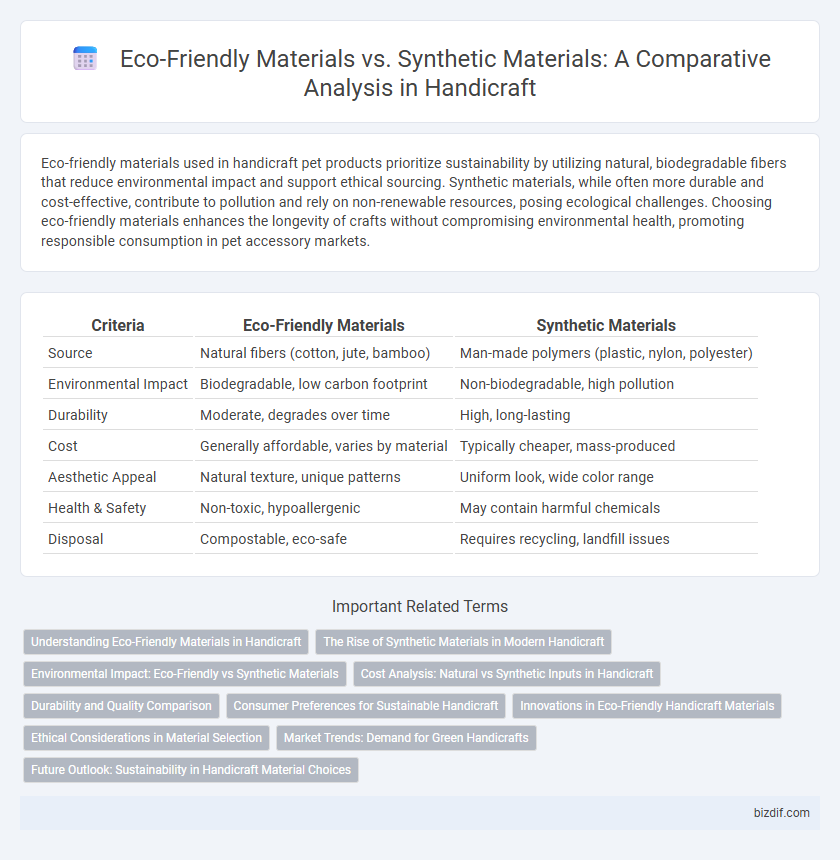Eco-friendly materials used in handicraft pet products prioritize sustainability by utilizing natural, biodegradable fibers that reduce environmental impact and support ethical sourcing. Synthetic materials, while often more durable and cost-effective, contribute to pollution and rely on non-renewable resources, posing ecological challenges. Choosing eco-friendly materials enhances the longevity of crafts without compromising environmental health, promoting responsible consumption in pet accessory markets.
Table of Comparison
| Criteria | Eco-Friendly Materials | Synthetic Materials |
|---|---|---|
| Source | Natural fibers (cotton, jute, bamboo) | Man-made polymers (plastic, nylon, polyester) |
| Environmental Impact | Biodegradable, low carbon footprint | Non-biodegradable, high pollution |
| Durability | Moderate, degrades over time | High, long-lasting |
| Cost | Generally affordable, varies by material | Typically cheaper, mass-produced |
| Aesthetic Appeal | Natural texture, unique patterns | Uniform look, wide color range |
| Health & Safety | Non-toxic, hypoallergenic | May contain harmful chemicals |
| Disposal | Compostable, eco-safe | Requires recycling, landfill issues |
Understanding Eco-Friendly Materials in Handicraft
Eco-friendly materials in handicraft primarily include natural fibers like organic cotton, jute, hemp, bamboo, and recycled wood, which reduce environmental impact through biodegradability and sustainable sourcing. These materials promote healthier crafting processes by minimizing exposure to harmful chemicals often found in synthetic alternatives such as polyester or nylon. Emphasizing eco-friendly resources not only supports ecological preservation but also aligns with growing consumer demand for sustainable and ethically produced handicraft products.
The Rise of Synthetic Materials in Modern Handicraft
The rise of synthetic materials in modern handicraft has significantly transformed traditional craftsmanship by offering enhanced durability, versatility, and cost-effectiveness. Unlike eco-friendly materials such as bamboo, jute, and organic cotton, synthetic options like polyester, nylon, and acrylic provide water resistance and longer lifespan, appealing to mass production and consumer convenience. However, this shift raises concerns about environmental impact and sustainability within the handicraft industry, prompting artisans to balance innovation with ecological responsibility.
Environmental Impact: Eco-Friendly vs Synthetic Materials
Eco-friendly materials in handicrafts, such as bamboo, organic cotton, and recycled fibers, significantly reduce environmental impact by minimizing carbon footprint, biodegradability, and avoiding toxic chemical use. Synthetic materials like plastics and acrylics contribute to pollution, non-biodegradability, and microplastic contamination in ecosystems, leading to long-term environmental damage. Choosing eco-friendly materials supports sustainable resource management and promotes healthier ecosystems in handicraft production.
Cost Analysis: Natural vs Synthetic Inputs in Handicraft
Eco-friendly handicraft materials such as bamboo, jute, and organic cotton often have higher initial costs due to sustainable sourcing and limited mass production, but they offer long-term value through biodegradability and consumer demand for green products. Synthetic materials like acrylic, polyester, and plastic are typically cheaper and widely available, enabling lower upfront expenses and consistent supply but pose environmental disposal challenges and potential regulatory costs. Cost analysis in handicraft production increasingly favors natural inputs as eco-conscious market trends drive premium pricing and brand differentiation, offsetting the higher procurement expenses of sustainable materials.
Durability and Quality Comparison
Eco-friendly materials such as bamboo, jute, and organic cotton offer sustainable durability with natural resistance to wear and tear, often improving over time with proper care. Synthetic materials like polyester and nylon provide consistent strength and enhanced water resistance but may degrade faster under UV exposure and are less breathable. Quality in handicrafts using eco-friendly materials is typically marked by unique textures and craftsmanship, while synthetic counterparts ensure uniformity and extended lifespan in high-usage products.
Consumer Preferences for Sustainable Handicraft
Consumers increasingly favor eco-friendly materials such as bamboo, organic cotton, and recycled fibers in handicraft products due to their lower environmental impact and biodegradability. Research indicates a growing demand for sustainable handicrafts that minimize carbon footprints and support ethical sourcing practices. Preference for natural dyes and non-toxic finishes also highlights a shift towards responsible consumption in the handicraft market.
Innovations in Eco-Friendly Handicraft Materials
Innovations in eco-friendly handicraft materials are transforming traditional craftsmanship by introducing sustainable alternatives like bamboo fibers, organic cotton, and biodegradable resins. These natural materials reduce environmental impact while maintaining durability and aesthetic appeal, offering artisans new creative possibilities without relying on synthetic plastics or chemically intensive substances. Advances in plant-based dyes and recycled textile blends further enhance eco-conscious design, aligning handicraft production with global sustainability goals.
Ethical Considerations in Material Selection
Eco-friendly materials in handicrafts, such as organic cotton, bamboo fiber, and natural dyes, align with ethical practices by reducing environmental impact and promoting sustainable resource use. Synthetic materials, often derived from petrochemicals, pose ethical concerns due to their non-biodegradable nature and contribution to pollution and health risks for artisans. Choosing eco-friendly materials supports fair labor conditions, biodiversity conservation, and a circular economy, reflecting responsible craftsmanship values.
Market Trends: Demand for Green Handicrafts
The rising consumer preference for sustainable products drives rapid growth in the eco-friendly handicraft market, with materials like bamboo, jute, and organic cotton gaining prominence over synthetic alternatives such as plastic and polyester. Market data indicates an annual increase exceeding 15% in demand for green handicrafts, fueled by environmental awareness and stricter regulations on synthetic waste. Craft artisans and retailers increasingly prioritize biodegradable and recyclable materials to meet this growing eco-conscious customer base.
Future Outlook: Sustainability in Handicraft Material Choices
The future of handicraft materials is increasingly shifting towards eco-friendly options due to growing environmental concerns and consumer demand for sustainability. Natural fibers, biodegradable dyes, and recycled components are becoming preferred choices for artisans aiming to reduce carbon footprints and support circular economies. Innovations in sustainable sourcing and material processing are expected to further enhance the durability and appeal of eco-friendly handicraft products.
Eco-Friendly Materials vs Synthetic Materials Infographic

 bizdif.com
bizdif.com